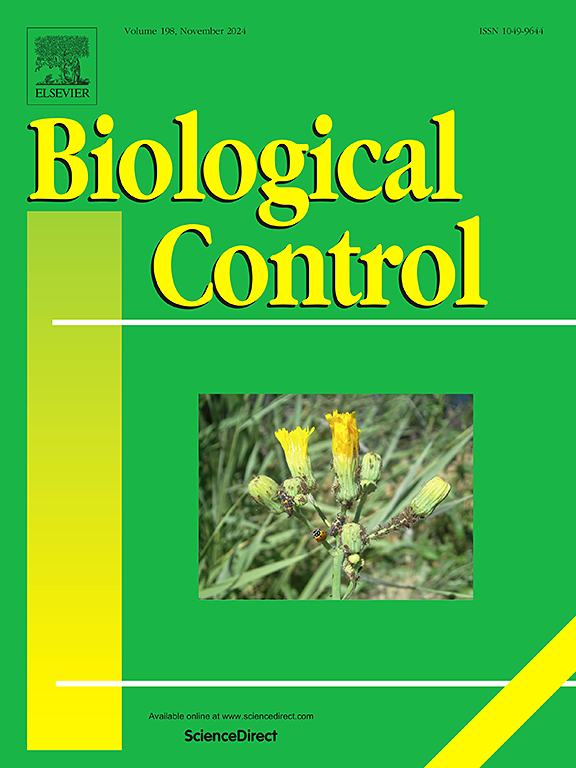Comparative responses of two congeneric larval parasitoids of emerald ash borer to ambient temperatures: Implications for biocontrol introduction
IF 3.7
2区 农林科学
Q2 BIOTECHNOLOGY & APPLIED MICROBIOLOGY
引用次数: 0
Abstract
Understanding how climate influences the establishment of introduced species is critical to classical biological control programs against insect pests. Even closely related species with similar life histories may establish and perform differently in new environments due to different responses to ambient temperature. Here we compared the host attack rate and immature development of two congeneric larval parasitoids of emerald ash borer (EAB) Agrilus planipennis Fairmaire, Spathius agrili Yang and S. galinae Belokobylskij and Strazenac, under a range of temperatures from 17.2 to 32.8 ℃. We found significant differences between the two parasitoids in host attack rates and progeny development. Spathius agrili could parasitize EAB larvae across the temperature range of 17.2 ℃ to 32.8 ℃ and caused the highest parasitism rate (∼90.0 %) at 28.9 ℃. In contrast, S. galinae did not attack any host larvae at 32.8 ℃ and caused the highest parasitism rate (∼92 %) at 25 ℃. From 21.1 ℃ to 28.9 ℃, S. agrili emerged on average nine days earlier than S. galinae and had a higher low-temperature threshold for development. Both species arrested their development as mature (5th) instars inside their cocoons at 17.2 ℃, suggesting facultative diapause that may be induced by exposure to cool temperatures. These findings suggest that S. agrili may perform better in warmer climates than S. galinae and could be an effective biocontrol agent in the southern U.S., whereas S. galinae is better suited to be released in the northern U.S.
绿灰螟虫两种同源幼虫寄生蜂对环境温度的比较反应:生物防治引种的意义
了解气候如何影响引进物种的建立对传统的害虫生物防治计划至关重要。即使是具有相似生活史的近亲物种,也可能由于对环境温度的不同反应而在新环境中建立和表现不同。在17.2 ~ 32.8℃的温度范围内,比较了绿灰螟虫Agrilus planipennis Fairmaire、Spathius agrili Yang和S. galinae Belokobylskij and Strazenac两种同属幼虫寄生蜂的寄主攻击率和未成熟发育情况。我们发现两种寄生蜂在寄主攻击率和后代发育方面存在显著差异。在17.2 ~ 32.8℃的温度范围内,农家螺都能寄生EAB幼虫,在28.9℃时的寄生率最高(~ 90.0%)。而在32.8℃时,galinae不攻击任何寄主幼虫,在25℃时,其寄生率最高(约92%)。在21.1 ~ 28.9℃范围内,农家乐平均比鸡鸡早出现9 d,低温发育阈值较高。这两个物种在17.2℃时在茧内发育成熟(5龄),这表明低温可能引起了同时性滞育。这些发现表明,在较温暖的气候条件下,农用玉米球菌可能比鸡鸡球菌表现更好,在美国南部可能是一种有效的生物防治剂,而鸡鸡球菌更适合在美国北部释放
本文章由计算机程序翻译,如有差异,请以英文原文为准。
求助全文
约1分钟内获得全文
求助全文
来源期刊

Biological Control
生物-昆虫学
CiteScore
7.40
自引率
7.10%
发文量
220
审稿时长
63 days
期刊介绍:
Biological control is an environmentally sound and effective means of reducing or mitigating pests and pest effects through the use of natural enemies. The aim of Biological Control is to promote this science and technology through publication of original research articles and reviews of research and theory. The journal devotes a section to reports on biotechnologies dealing with the elucidation and use of genes or gene products for the enhancement of biological control agents.
The journal encompasses biological control of viral, microbial, nematode, insect, mite, weed, and vertebrate pests in agriculture, aquatic, forest, natural resource, stored product, and urban environments. Biological control of arthropod pests of human and domestic animals is also included. Ecological, molecular, and biotechnological approaches to the understanding of biological control are welcome.
 求助内容:
求助内容: 应助结果提醒方式:
应助结果提醒方式:


